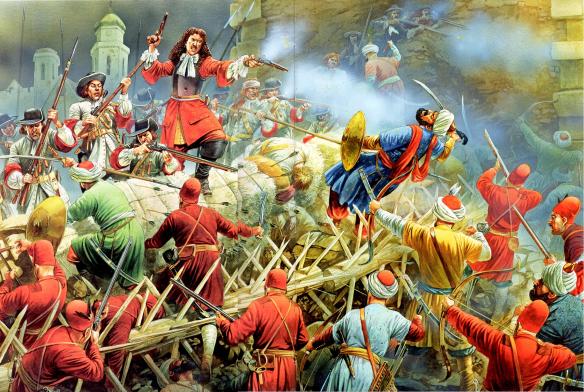Imperial defenders Vienna, 1683
In southern Slavic languages, husar was a mounted knight. Polish hussaria (‘winged horsemen’) dominated Central and Eastern Europe battlefields throughout the century and were central to the relief of Vienna, 1683.
Until the mid-17th century, while the core of all Polish armies continued to be noble heavy cavalry and units of hussars. From the early 16th century, a force of 3,000 Polish cavalry and a few infantry served the “General Defense” (“Obrona Potoczna”) against Tatar raids into the south. This was not a true standing army, as its soldiers were part-timers who owed labor service to local lords or the king. From 1566-1652, it was known as the “Quarter Army” (“wojsko kwarciane”). Until 1648, Polish medium cavalry, regardless of origin or ethnicity, were known as “Cossack cavalry” (“jazda kozacka”). These units painted their horses with red dye, dressed in wildly irregular ways, and used many types of weapons. They liked sabers in preference to lances, but they also used bows and short spears. After 1648, they were known as “jazda pancerna,” or “Pancerna cavalry.” Polish hussars were modeled on Hungarian hussars, except that most Polish cavalrymen hailed from the szlachta, or higher nobility, and their retainers. Polish hussars comprised one “comrade” (“towarzysz”) and four retainers (“pacholeks”). This was reduced to two pacholeks in the late 17th century. Over time, Poland’s hussars grew heavier in horses and weapons and evolved into medium cavalry.
The predominance of cavalry in eastern European warfare spoke to greater requirements for mobility on the steppes and northeastern plains, especially compared to the confined and fortified frontier zones of France, the Rhineland, Italy, Hungary, or the Netherlands. Tension between cavalry and infantry was high in Polish armies. This reflected a unique strategic dilemma faced by the Commonwealth: the light cavalry it needed to deal with the Tatars in the south were mostly useless against Swedish or Russian infantry, artillery, and field fortifications in the north. Conversely, Polish infantry and artillery needed to fight Swedes and Russians were highly vulnerable when facing fast-moving Tatars and Cossacks.
Between 1500 and 1512 the empire was divided into ten military districts or circles, kreise – the Franconian, Swabian, Bavarian, Upper Rhenish, Electoral Rhenish, Westphalian, Lower Saxon, Upper Saxon, Austrian and Burgundian. When the emperor required a German army he summoned the Army of the Circles, which, according to an edict of the Diet of Worms in 1521, was fixed at a minimum of 4,000 cavalry and 20,000 infantry, each circle making pro rata contributions in troops, money and equipment. This basic establishment of 24,000, known as the simplum, was revised upwards to 12,000 horse and 28,000 foot in 1681; when more troops were required, the simplum was doubled (duplum) or, more rarely, tripled (triplum). The duplum was invoked in 1683 when the Turks besieged Vienna and again in the winter of 1688-9 during the Devastation of the Palatinate. Some small states commuted their obligations into a money payment that was used to raise additional men from the larger polities. Being impermanent, the Army of the Circles was normally ill-trained, badly disciplined and indifferently commanded. Larger states donated their worst regular units because they were usually under some political obligation or mercenary treaty opposed to Imperial interests.
Poland’s vast territories stretched from the Baltic in the north to the borders of Hungary in the south and from Muscovy in the east to Austria and Brandenburg-Prussia in the west. Paradoxically, Polish society was substantially militarized, yet the state was unable to defend itself adequately against a ring of predatory neighbours. The principal difficulty was the size and political independence of the Polish nobility: by 1773, 12 per cent of Poles claimed noble status, and in the provinces of Podlasia and Mazovia there were more aristocrats than peasants. Not that there was much to distinguish one from the other: most nobles were as poor as peasants and sought protection by joining the private armies of the few rich magnates. The king could not compete, hence in Poland the ‘monopoly of violence’ remained with the nobility and did not migrate to the sovereign. Although royal rents financed a standing force, founded in 1564, the Sejm (the noble diet), fearful that – the elected monarch would institute military rule, ensured that he was starved of additional funds. Thus this ‘Crown Army’, rarely larger than 30,000 men and formally established at 24,000 in 1717, was confined to frontier defence and never grew sufficiently to enhance royal authority When John III Sobieski (1674-96) raised an army to help raise the Turkish siege of Vienna in 1683, his 25,000 troops were accumulated very slowly from amongst the feudal noble cavalry, foreign mercenaries, and the infantry of the Crown Armt. A feature of Polish armies was their preponderance of cavalry, recruited from the ubiquitous nobility, instead of cheaper and more flexible infantry. By the early eighteenth century the ratio was as high as four horsemen to each foot soldier, when most European armies enjoyed an inverse proportion.
